Star Trek The Motion Picture, or Star Trek TMP, is the Phantom Menace of the Star Trek franchise. Featuring a bi-polar plot that never connects, it’s the feature film equivalent of a “Monster of the Week” style Trek TV episode.
If you have a Roku or other device you can see the first three Star Trek movies for free uninterrupted right now using the DUSTx app/channel. So it seemed like a good time to rewatch and review them in order.
Star Trek roars into theaters for the first time on December 7, 1979 with a whimper in the form of this bad film redundantly named Star Trek The Motion Picture.
In a Nutshell
Its A Mess! This movie is just not that good!
The plot is a little complex and assumes full knowledge of the series. It was born and spent most of its life as a TV pilot. There was no “Un-TV-ing” the way its paced. It’s important to remember a switch is literally flipped when they realize its going to be a feature film. Then the TV pilot tries to be a movie and it’s at odds with itself. In essence it’s a miffed attempt to re-boot the TV series that ended up sucking up so much money they can’t just walk away; so it fails its way up to feature film.
We’d seen a very similar story before in the TV episode “The Changeling“, which is imaginative among episodes, but not a movie-building episode. I can only imagine they were going for something closer to what we get in the pilot for the Next Generation.
This supposed pilot had things it needed to do as a pilot. Re-Introducing the original characters and giving us some new characters through an interesting monster of the week two part episode with an emphasis on showing the ship and the gear and setting up future episodes was more important than making the single best episode of the series. So motivations aren’t really there to make a movie at all, or even a really good episode. There were people lined up around the block looking to write the new episodes too. We get the best ones later in the Next Generation.
Development Hell
In fits and starts some stuff was getting done, but it’s just not going anywhere. The plugs not pulled but things slow down while Paramount reconsiders. Things are up in the air.
Star Trek TMP was on its way to a similar fate as another failed Star Trek pilot “The Cage”. It’s tempting to the network, and Roddenberry could sell Star Trek, but sci fi is dead. So it kind of ended up in what they call “Development Hell.’
“Development Hell”, a term first popularized by Tim Burton, is what killed off his mediocre Superman movie but produces this bad Star Trek movie. It’s a term for a movie or show that’s got some elements in place, but not quite enough. Outright bad ideas don’t end up there, they die. On paper a Star Trek movie is actually a good idea, especially when the second release of Star Wars A New Hope is just vacuuming up money. And that outside development was the final thing that bought Star Trek back.
So basically it’s just pulled off the scrap heap and gets a pretty big injection of cash for cinematic special effects really late in the game. This is why some effects are much better than others.
In Real Estate terms, this wasn’t a complete teardown so much as huge a refurbishment with a poorly planned addition.
The Really Expensive Pilot that Just Didn’t Work
This pilot had problems from the start. The biggest was Star Trek rip off, TV show Space:1999. The Star Trek people probably knew they had problems when they saw that there were a few too many similarities between their new production and this show.
I think the similarity the new Star Trek production’s look had to that of bad TV show SPACE:1999 cheapens their vision right in the moment. I’m sure it bothered the writers and creators, who immediately move on from this look. The Space:1999 people seem to have blundered into this and the Star Trek people just found out too late. You can’t very well look like a bad TV show when you’re making the jump to film, but it was too late and unfixable.
And it was a bad vision of the future. Never easy to do anyway, but this ends up worse than most. No expense was spared in creating a huge series of only okay sets that would have seen heavy use in a series. They saved what they could but most of it looked wrong.
It’s fair to call the uniforms and this movies Enterprise a dead end experiment. Sick Bay may have been an exception to an otherwise bland Enterprise, but the future has caught up and many of us have seen our CAT scans and MRI’s in real time on a big screen, so it’s a push there.
As I mentioned, it’s sort of a Star Trek tradition to have a pilot fail and then re-emerge in a slightly altered form. Similarly, this failed pilot is re-cut into a bad movie on the fly.
It was “throw this out there and get what we can or forget about Star Trek forever.” There was only one choice for the Star Trek people. They rebuilt the movie as best they could on the fly and prayed some heavy effects scenes would carry the movie.
They were pretty much wrong.
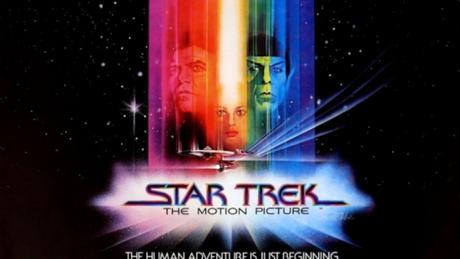
So all this ran out of gas maybe 6-18 months before Star Wars is released. When a lot of this work is being done there didn’t seem to be a huge interest in Science-Fiction. Then 1977 rolled around and Star Wars begins a Sci-Fi craze like never before. A bunch of franchises ride its coat tails into mainstream success.
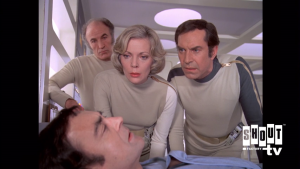
Space:1999 featured a similar look
Ironically, Paramount’s disdain for the project helps prolong it and ends up keeping the idea alive long enough that the movie does get made when things change and sci-fi is hot again (and forever) in the wake of the 1977 Star Wars movie, aka Episode 4. If production hadn’t been so far behind we may have lost Star Trek forever. So it was a fluke this gets released. So we owe something to this reckless decision that pays off.
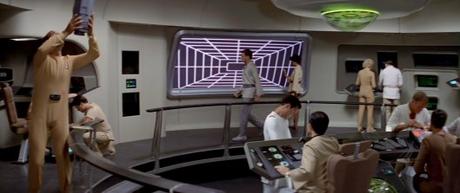
Starfleet’s New Look
Star Trek Stops Losing Money
So now the public is hungry for Sci-Fi and Paramount wants in. Looking around, the fastest path is a half finished Star Trek pilot on the ‘In Need of Help’ pile. It’s not that good, but hey, it’s almost done! It can be in theaters pretty quickly.
There was also just a lot of Star Trek fans out there having conventions and buying lots of merchandise even after Star Wars. So there was demand and an audience for a Star Trek movie. It had become iconic in re-runs worldwide.
It was all found money for Paramount. They couldn’t have been happier. The only reviews that counted came from the people over at accounting! This passed over pilot had been really costly. And really slow. Now, the studios attitude towards Star Trek changed considerably. It was finally set up to make a profit.
The decision was made. They would finish the pilot as a feature film. They throw another 15 million bucks, a fortune in 1979, into cinematic effects and do what they can with what they have.
This was never going to be all that good of a TV show. We don’t know exactly when they made the decision to go from TV to intentionally mediocre movie, most sources say two thirds in to filming, but a lot of the scenes remain very TV-like. They were writing as they were filming at the end. So now things get frantic.
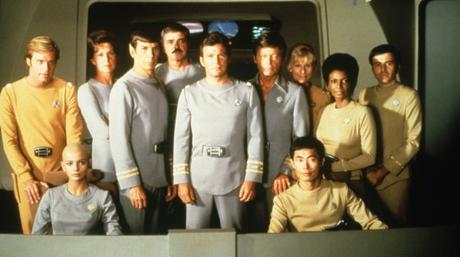
not everyone’s gonna make it to the end
The Biggest Problem
My Guess? At some point Gene Roddenberry has too much control and all the delays give him too much time to think and make bad decisions. Then they pulled away a lot of control with a deadline and some harsh takes on his results so far.
And times really changed in the roughly five years it takes from start to finish with this Star Trek project.
When things start out 2001 A Space Odyssey is the standard for big screen sci-fi. Before they’re done Star Trek’s original 1977 release had really, really changed things. Special Effects not the least.
V’ger ends up a badly done alien-villain by the time they are ready to release this movie. The only got some of the pop they had hoped for from the Special Effects. The 1974 ideas may as well have been 1954 ideas after Star Wars hits theaters. They looked bad.
The One Good Hire
While much of what we see onscreen is sort of bad when you watch it now, they do start introducing some recurring themes and make a key hire. Composer Jerry Goldsmith, who did the music for the series and was in fact a very in demand movie score guy at that point, was bought on to handle the musical score.
They were smart and right on to get back Jerry Goldsmith to work on most of the music for this movie. Reunifying him with the franchise is maybe the most important thing this movie gets us. His contributions are not to be underestimated. We have the forst ever attempt at the Next Generations theme used in the movie. We also get the Klingons now familiar theme song from the first time in the cold open.
The soundtrack, for the most part, is good. The Star Trek music is as good as the Bond Music as far as themes go. And on par with some Star Wars movies as well. It assures some continuity in the series to the movies mere atmospherics could never have accomplished.
There’s some characters with theme music just like in John Williams movies. The evil cloud, for instance, is always accompanied by harsh synth music when it manifests its various guises.
The Controversial Firing
Whatever else he may have done, the one thing Gene Roddenberry had absolutely cemented in Paramounts minds was he was an idea guy and a TV Guy, NOT a Movie Guy. His Star Trek movie was not what they wanted and he had serious objections to the studios ideas. They also already had some problems with things he was saying about the sequel, which scare them even more about giving him control of the movies.
He was gets pushed out to a degree and his lack input to the movies (but perceived prowess on TV) gets us the amazing Next Generation. So in a way it all worked out. Gene Roddenberry later has similar issues with the Next Generation, but his somewhat untimely death resolves that.
The key decision that Star Trek didn’t always have to be profound is made. Sort of like Pink Floyd when they part ways with Roger Waters. They wanted to be meaningful and artful, but they also weren’t always going to make some deep statement. It was freeing in both instances. It was the right decision for Star Trek, where the wrong approach makes a movie self-important the way this one is. Remember the tagline for this release is “the Human Adventure Has Just Begun.” Pretty important sounding and the movie never achieves anything that makes you feel this is true.
Sometimes we’re just gonna have fun in this ready made Galaxy. We might allude to something larger here and there in an observational way, but everything doesn’t have to be Asimov-level profound. Being meaningful was still out there, but profundity was not the number one goal anymore.
It worked. “Double God Damn on You!” is funny when we get there in Star Trek 4.
Incongruities
It’s still essentially a TV script and its partly made when they switch gears. While thats part of its appeal to the producers, it leads to some uneven pacing when the movie slows way down later.
We also get a couple of very doomed new characters leftover from the days of it being a pilot. They just don’t fit anymore, but they have key roles in the story and maybe some of the already filmed scenes. We can pretty much figure out what’s going to happen to them.
New character Captain Will Decker is the only qualified non dinosaur around, but he’s been quickly, curtly demoted and, shall we say, Red-Shirted. This was also going to happen if it stayed on TV. He was going to be Kirk’s Number One.
Then we have Captain Decker’s ex girlfriend, whose inexplicably verbal about being celibate. Welcome aboard Navigator Ilia, who I guess gets downgraded from TV cast member to “Hottie of the Week”. Her shaved head is less disturbing now then it was in 1979. They’re an early, underdeveloped version of Riker and Troi. So we’ve seen this done better too since this movie.
Shes not an effective alien even when she returns in ‘replicant’ form.
They never seem like they’re going to make it to the end of this movie. This isn’t helped by the fact the movie itself at one point seems it will never end!
It’s the first appearance of a Seventh Heaven cast member in creepy Stephen Collins, who was at least okay in his not so great role. His Seventh Heaven TV wife shows up in Star Trek IV as a Marine Biologist.
The Mediocre Movie, Act 1
As revealed later its 2 years since the Enterprise ended its 5 year mission, so 7 years from start of the Mission and our season one stories. Everyone looks pretty much the same. Its an evolutionary moment in the lifespan of William Shatner’s hair, he has a strange piece or weave, but the Shat is BACK and Kirk-er than ever!
The movie opens as the Anomalous Cloud later revealed as V’ger easily destroys 3 klingon warships in true 70’s sci-fi fashion. The primary weapon of the cloud is best described as ‘bad’ and has a pretty laughable effect when it actually destroys anything. The point is made though – don’t mess with the cloud.
Fortunately for the Klingons its just passing through their neck of the woods on its way right to the homeworld of the hated and annoying Federation. So they just leave it alone. In due course it consumes a Federation listening post at the edge of Klingon space.
With TV-like brevity we get a quick glimpse of Spock flunking his try at the Kolinar Emotional-Purging Ritual, which is presented as lengthy and difficult and shows a stressed Spock with long hair. Then, assuming full familiarity with the series we get a mind meld that we may not have really needed where we learn Spock is sensing V’ger.
We transition to an actually pretty cool looking Starfleet Headquarters and find out right away Starfleet Command is hyper focused on the Anomalous Cloud that defies all analysis. Chief of Starfleet Operations, Admiral Kirk, is point man on this one and he’s game, but he also has his own agenda- to be Captain of the Enterprise once more.
Admiral Kirk and Scotty, whose still chief engineer of the re-vamped Enterprise give us a real show of the Enterprise as the move around in a shuttle to dock with the Enterprise, refit and snow white.
At TV speed we find out Kirk’s far more taken with the idea he’s back in the Captain’s Chair than with the enormity of the impending encounter with the dangerous cloud. He’s James T Kirk, he does deals with this all the time.
The ultra clean Enterprise is going to become a constant in the series and on TV but we never see the Enterprise looking quite like this again. Its white and spotless. The main sensor array is just a glowing blue disk. There’s lots of humans hanging around it for scale reference and the movie ends up behaving more or less like a TV pilot.
In a TV Pilot-like manner Kirk busts Captain Decker to “Executive Officer”. Decker takes this well enough, but he doesn’t mince words calling the Admiral a manipulative jerk. He’s right too. Who cares? This is a man whose father almost destroyed the Enterprise tangling with the Doomsday Machine in a great TV episode. Good command decision isn’t in his DNA anyway.
The Enterprise itself gets an almost character-like intro. The convenient reunification of the characters is amusing only with McCoy. You could be excused from missing Janis Rand completely. Shes one of the horrified transporter crew that melt a couple of crewmembers. It’s one of the few moments the movie has any emotion.
Minutes later Kirk’s pretty glib about the transporter as we get the aforementioned 2 amusing minutes courtesy of Dr McCoy, whose more than a little angry over having been drafted back into Star Fleet.
In short order we reassemble the most of the original crew plus some bland toss ins. We move via the Enterprise to intercept the Cloud, eventually to be known as V’Ger, which no one bothers to keep consistent in size. Best guess is its about the size of our solar system and is emimating enormous power readings.
Act 2
We get what at this point is a brand new concept – the ships not quite finished and the crew is not that trained, but there’s a threat and its the only Federation ship in the area. This will get re-used a whole lot but this is its first invocation in the movies.
While en route to intercept the cloud Kirk pushes everyone too hard and the opportunity for another very 70s moment of special effects shows up in the form of a Worm Hole created by an imbalance in the warp engines. Then his mistakes is compounded by an asteroid pulled into the ships path. They have just a few seconds to figure it out. We get another very 70’s moment where time is passing slowly and everyones speech is slurred. Showing his ignorance of the new design Kirk orders a phaser blast while at warp and Decker saves the ship by countermanding Kirk’s order and using a photon torpedo instead. Brief tension ensues.
This is a deeply technical and not so good sequence that really hurts the movie. The effects are bad.
Then, the first cast member we saw briefly and then veered unevenly away from returns as a shuttle with Spock arrives to dock with the Enterprise. The whole desert emotion-purging thing has Spock acting like he’s abusing downers. He’s not going to reach his normal conversational level that quickly. He, like Kirk, has his own agenda anyway. The anomaly is what reached out and stirred his human emotions and ruined his training in the first place. He assumes science officer duties and for once Decker is happy to yield ground.
Kirk, Spock and McCoy are in place, so your pretty sure things are gonna be okay. Spock is somewhat ‘communing” with V’ger. He can’t elaborate on it just as the sensors can’t quite pin down the makeup of the cloud. It’s been done in a real “checking off the boxes for a TV pilot” way. You gotta imagine most of the effort was going to try to find an ending for this movie at this point as they rewrite on the fly.
We find the ship offline to a degree for a moment while Scotty applies Spock’s convenient software patch and fixes the warp engines. We’re off to meet the cloud.
When we finally get to the Anomaly, Kirk doesn’t probe it and leaves down the shields. He’s dead set on not triggering its defenses, which are as effective as they are silly. The shields hadn’t helped the Klingon’s, right?
Approaching the Anomaly we get some pretty state of the art attempts at effects for 1979, but they.re by no means astounding. There’s some great exteriors of the ship flying through the cloud. If you only like Enterprise-porn, where they just show off the ship, you’ll love this movie.
A game of cat and mouse ensures and the Enterprise is sort of engaged with V’ger, eventually entering the cloud and barely escaping destruction by persuading the entity at the heart of the cloud, that they’re not a threat moments before it would have atomized the ship.
Act 3
The movie is now primarily trying to find it’s way to a few Star Trek moments and to feel cinematic after a lot of TV shooting and pacing. It really slows down in the final act. It feels uneven because it is.
At some point the Enterprise manages to end up inside the giant ship within the cloud and we find out the V’Ger entity has really been around. There’s a visual library of a very extensive journey.
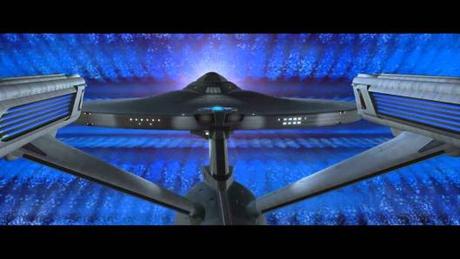
the Enterprise approaching the outer event horizon of the V’ger Cloud
A sensor wave from the cloud cuts through the bridge but seems to cause no damage. Then it fries the navigator, Ilia and with the sum of the ships computers knowledge it simply disappears.
Meanwhile there’s some form of communication coming from the cloud and the Enterprise finally picks it up. With some communications established we get a ride through the cloud.
Eventually we get our navigator back but now shes a scantily clad replicant-like emissary from the Anomaly, which finally announces itself as V’ger. She has little to offer about V’ger’s nature and is more about checking out the carbon based life forms the ‘infest’ the Enterprise.
Since they used to be lovers, Kirk has Decker hang out with the thing and show it around. It would seem it deeply affects him. Kirk’s pretty perplexed and the stakes are going up as they approach Earth.
Meanwhile Spock shows off what surely would have been heavily used gear in the show, a rocket powered spacesuit that’s pretty imaginative.
So anyway we have Spock outside his ship, which is inside another ship, attempting to penetrate further into the V’Ger entity to get some clues about just what this thing is. He finds enough to get overwhelmed and the 2001: A Space Odyssey is playing deeply in to the effects approach and it’s not unlike Bowman’s journey from The Discovery to meet god.
When we see Spock again hes drifting in fetal position towards a spacesuited Kirk in a possible heavy handed salute, or attempt to draw a little legitimacy from Kubrik’s movie. It isn’t all that bad, I suppose its a high point in the now slow moving movie.
V’ger attempts communication with Earth but gets no response and then, in a moment we see again soon in Moonraker, it starts to deploy killer satellites around the planet and gets ready to rid the planet of the Carbon based life forms (so humans and everything else). By doing this it hopes to contact it’s creator, whom its obsessed on.
Attempts at pop psychology and other justifications for the V’ger entities motivations and all of them are heavy handed and bad.
Kirk bluffs the Ilia Clone Probe thing and we all take a walk across the outside to the the heart of the V’ger entity, it’s mysterious origin and form soon to be revealed
Again leaving the ship but now just wearing some spiffy jackets and walking down the saucer section, V’ger is finally revealed for what it is- a lost 20th Century Space Probe FROM NASA back on EARTH!
Kirk removes 3 centuries of Space grit with his hands to show what the machines on the machine planet who super-empowered this probe missed; the true name of V’ger is actually Voyager 6! All we need is the old NASA code and this baby will turn right off. The bridge crews right on it!
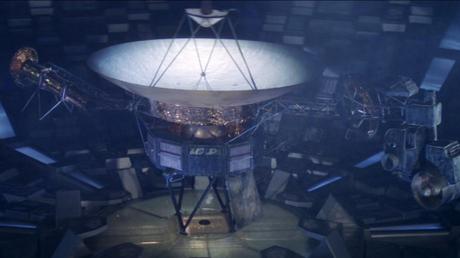
the Heart of V’ger, NASA Probe Voyager 6
We quickly hear that Voyager 6, programmed to gather information and return to report it, fell into a Black Hole. Then, mostly because we’ve seen all this before in the episode “The Changeling” , the away team deftly auger that it must’ve emerged on the other side of the black hole and crashed onto a planet run by super intelligent machines. Imagine THAT happening TWICE? And much later it will happen again in another movie in this franchise. This plot device should be avoided forever more. 3 times is enough. Whiplash for even me at 9 seeing this. Seemed unfair to just throw a slightly higher budget twist on to one so-so episode as your movie.
Kirk reveals it to V’ger in true Shatnerian form; “V’ger, WE are the Creator”
This is a total let down to V’ger. It immediately becomes depressed.
Goodbye Inconvenient Characters
Ilia is now just a replicant and Decker has no role in this new dynamic. He decides he would love more than anything else to do a couple of screwdriver turns and key in the final command codes, confirming mission accomplished. Everyone has somehow figured out this is going to cause some sort of mergence between himself and V’ger. He has to do it manually because V’Ger itself burned out the leads to avoid admitting to itself the annoying carbon based life forms are its Creator.
So Decker keys in the codes and via really questionable effects we see Decker and Ilia merged.
The V’Ger entity is now a lot happier and a little more complete, so it seemingly goes unsaid it’s no longer a threat. No one bothers to ponder the idea this man made death machine has genocided its way across the Galaxy. And we never hear about this strange plot device again. This enormously powerful entity simply goes away and is never spoken of again.
In TV Style the movie wraps up with Kirk, Spock and McCoy pondering and exchanging verbal jabs on the bridge.
Roll Credits!
The Good
The acting in this movie exceeds what they had in the script. The cast comes off authentic. Everyone’s well prepared to reprise their character. The new cast members, well, we wont have to put up with them that long, but they’re okay.
And we found out that Star Trek could succeed without being profound, which was what this movie tries and fails to do. It was so bad that part gets lost in the many other criticisms.
We have Jerry Goldsmith onboard doing the music and we have the original crew well set up to do more movies. Thats all we get. ‘Star Trek’s back, but we’re gonna have to work on it a little more’ is the message here.
Some special effects are pretty cool. The musical score is mostly good.
Seems like with leaving almost all of this behind is the sort of thing we could have skipped, and we could have. Unlike Phantom Menace, which is about as bad, it serves no purpose in the continuity of the series. One of the best parts of this movie is you can easily skip it and still enjoy the other films. Almost nothing is the same when we get the next movie, Wrath of Khan.
In the end the best part is what didn’t happen. It didn’t become a pilot for what would probably have been a mediocre Star Trek show and never had gotten the excellent Next Generation at all.
The Bad
Where do you start with a project so deeply flawed? At it’s worst moments this movie takes itself far too seriously and then makes a confusing glib turn. Its uneven and the pacing drops off once we encounter the V’ger cloud.
The new characters are bad and have the smell of red shirted death on them the whole time.
Long preposterous chunks of dialog of Star Trek speak aren’t as prevalent as moments showing Kirk as unflappable and rigidly determined, but theres too much of both.
Rather than Majel Barret the ships computer has a harsh male voice, probably influenced by 2001’s male voiced HAL 9000. This is jarring and a let down.
Most effects aren’t so great, some are distractingly bad. Plot-wise V’ger is just Moby Dick and the Death Star mixed together. The similarities to the episode The Changeling wouldn’t have been so bad if this had ended up a pilot.
The ‘save’ attempts are hit or miss. They never have cool uniforms. we see some updated phasers but there’s no action in this attempt at a cerebral movie. The movie’s makers realized the best case was for TMP to be kind of okay. When they try to make it seem like theyre being deeper and thoughtful they try Kubrik-like effects and elements and it doesnt work in a big way.
The smaller, faster earlier scenes are at least brief. When we end up in the depths of V’ger the movie slows down and seeks some kind of direction and redemption. A real pay off is sort of not possible. The effects were good enough for 1979 but just barely and things that wouldnt have been quite as bad on 70’s TV are simply awful on the big screen or a modern HDTV.
This whole movie is bad. Its bad Star Trek, its bad TV and it’s a bad feature movie. It wasn’t well reviewed, though some notice was taken of some of the better special effects.
The look of this Enterprise is a one off. The outside is never this white again, going woth a more believable buish metal look. Inside maybe some of the Engine Room was reused but not much. Its the hugest engineering section we see in this series.
Next journey, to do battle with Khan, we have more Industrial bridge and a more tactile looking, somewhat Star Wars influenced bridge that looks more functional and has some military-like sparseness. This movies bridge is like the one JJ Abrams liked to show. Large, bright and with more crew than it would seem to need. It seems to have some Next Generation set elements in it. We know everything in Star Trek has several lives as a prop. Future bridges in this series are far darker and less populous.
This overall look for the Enterprise wasnt going to work and there’s a rare but huge fail on their uniforms and communicators too. Everyone looks like theyre in their pajamas.
By the next movie more military style uniforms simply work better.

The more familiar uniforms for the rest of this Series of movies
Perhaps oddest of all, theres NO BRIDGE AMBIENT SOUND. Takes a moment to realize it but then you really miss it. Here and there a button gets pushed and there’s a reactive sound, but aside that the technical background of ambient startship bridge noise isn’t there. We didnt realize how much we count on this great foley art was to helping us to believe it all til it was absent. It definitely stands out when they talk on the bridge, undercutting the believability. It’s a weird choice.
The Legacy
The legacy of this movie was making just enough money to greenlight Wrath of Khan and all subsequent movies and shows. This could have been the end of the line without seeing the light of day. If anything demand was so high they could skate on an bad movie if there was a good one in the development pipeline!
Still, I was thrilled leaving the movie as a kid just because I’d seen my Trek hero’s again. I was really happy there would be more Star Trek in the future!
Paramount’s take was kind of pure profit considering they’d scrapped the pilot and still recovered anything! They had finally recouped some money and Sci- Fi was hotter than one bad Star Trek movie could ruin, and so, with some serious strings attached, greenlight another movie. It that point there first movie had sort of overperformed and revealed the fanbase had indeed grown. It wasnt a blockbuster or that great, but in Hollywood money and making money is all its about. In a weird and circuitous way- Mission Accomplished.
So sit back, grab a strong drink and get through not so great Star Trek The Motion Picture. Or not. The next movie starts a story arc that ignores everything from this movie including Kirk being in command.
Star Trek The Motion Picture is the Phantom Menace of the franchise. Only the really strong story and box office success of the sequel justifies the existence of this movie. Basically for Paramount there was only interest in using House Money from this project to give a revamped Star Trek writing team, with a minimized role for Roddenberry, one more shot to succeed.
From this movie came the long enduring “Odd Numbered Movie Curse” peculiar to Star Trek where only even numbered sequels did well or were well reviewed. In the Abrams universe/ Kelvin Timeline its reversed. The odd numbered movies are better.
For that alone this bad movie is justified. But its really not that good.
Advertisements

